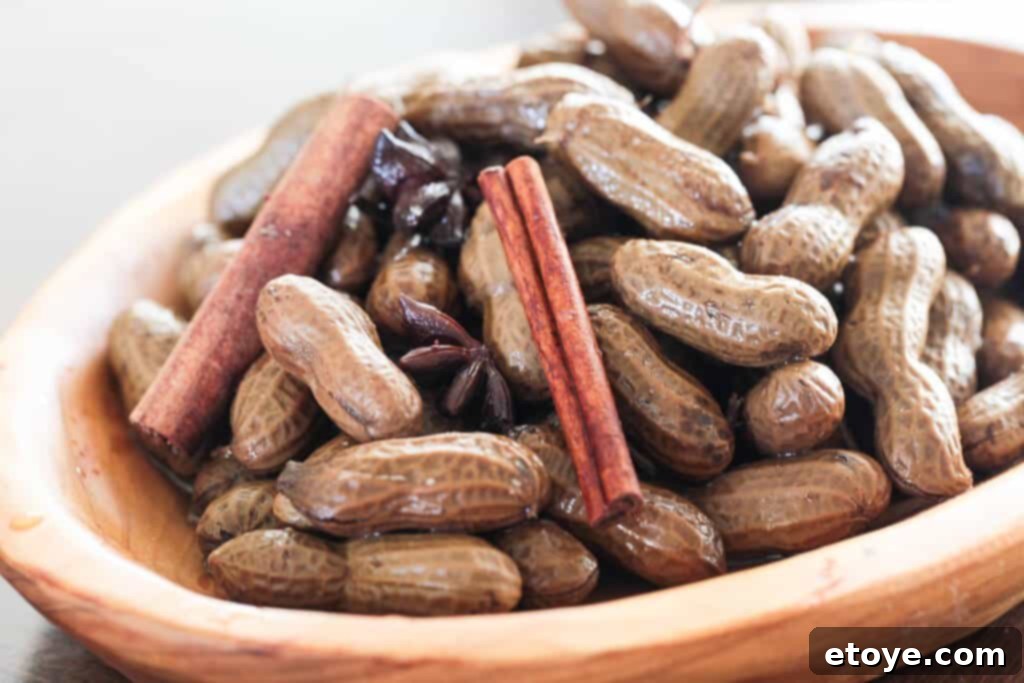Welcome to the captivating world of Chinese Boiled Peanuts, a beloved snack that embodies simplicity, comfort, and an explosion of unique flavors. This recipe guides you through creating these irresistible morsels, transforming raw peanuts into a tender, aromatic delight infused with the warm embrace of cinnamon, the distinct sweetness of star anise, and the savory depth of garlic. What makes them truly special is a molasses-like sweetness that develops during the boiling process, even without a single grain of sugar, creating an experience that’s both comforting and undeniably addictive.
Often referred to as ‘water peanuts’ or ‘spiced peanuts’, this humble yet extraordinary snack is a staple across China, particularly during the cooler months. It’s more than just food; it’s a culinary journey that evokes warmth, nostalgia, and the vibrant essence of authentic street food culture. Prepare to elevate your snacking game with a recipe that is surprisingly easy to execute but leaves a lasting impression.

Why You’ll Love This Chinese Boiled Peanut Recipe
There are countless reasons why Chinese Boiled Peanuts stand out as a fantastic snack, making them a must-try for any food enthusiast. Their unique blend of flavors and versatile nature ensures they’re a hit in any season or setting:
- A Symphony of Delicious Flavors: Unlike roasted peanuts, boiling infuses the peanuts with a complex, savory-sweet profile from star anise, cinnamon, and garlic, creating an unparalleled taste experience that’s deeply satisfying.
- Authentic Chinese Street Food Experience: This recipe brings the essence of a popular Chinese street food snack right to your kitchen. It’s a taste of tradition, offering a glimpse into the comforting and flavorful world of Asian culinary delights.
- Perfect for Cooler Weather & Cozy Evenings: While enjoyable year-round, these warm, tender peanuts are especially comforting during autumn and winter. They provide a soothing warmth that makes them an ideal snack for chilly days or cozy evenings at home.
- Excellent for Entertaining and Parties: Easy to make in large batches, spiced boiled peanuts are a crowd-pleaser. They’re a unique appetizer or side dish that’s perfect for gatherings, offering a healthier and more interesting alternative to conventional party snacks.
- Nutritious and Wholesome: Peanuts are packed with protein, healthy fats, and fiber, making this a much healthier snack option compared to many processed alternatives. It’s guilt-free indulgence at its finest.
- Incredibly Simple to Prepare: Despite their rich flavor, the cooking process is straightforward and doesn’t require advanced culinary skills. It’s mostly hands-off, allowing the spices and peanuts to meld beautifully over time.
- Highly Customizable: The base recipe is fantastic, but it’s also a canvas for culinary creativity. You can easily adjust the spices to match your personal preference, adding a touch of heat, more savory notes, or even a hint of sweetness.
Essential Ingredients for Perfect Chinese Boiled Peanuts
Crafting these flavorful boiled peanuts requires just a few key ingredients. The quality of your raw peanuts and the freshness of your spices will significantly impact the final taste, so choose wisely!
- Raw Peanuts (Green Peanuts): This is the cornerstone of the recipe. Ensure you use *raw* peanuts, preferably “green” peanuts which are fresh, undried, and still moist in their shells. If using dried raw peanuts (shelled), a crucial overnight soak is necessary to rehydrate them, reducing the cooking time and ensuring a tender texture. Do NOT use roasted peanuts, as they will turn mushy and lose their distinct flavor when boiled.
- Garlic Cloves: Peeled and slightly smashed, garlic adds a pungent, savory base that complements the other spices beautifully, rounding out the flavor profile.
- Star Anise: A truly distinctive spice, star anise provides a unique, sweet, and slightly licorice-like flavor that is characteristic of authentic Chinese boiled peanuts. Don’t be scared by the licorice note; it’s subtle, warm, and nothing like black licorice candy.
- Cinnamon Sticks: Whole cinnamon sticks contribute a warm, sweet, and woody aroma. They add a comforting depth and a hint of natural sweetness that is essential to the overall flavor. The quality of your cinnamon can affect the intensity, so adjust the quantity accordingly.
- Kosher or Sea Salt: Salt is vital not just for seasoning but also for creating the brine that penetrates the peanuts, enhancing their natural flavors and preserving them. Kosher or sea salt is preferred over regular table salt for its cleaner taste and lack of iodine.
- Water: The unsung hero! Sufficient water is needed to fully submerge and boil the peanuts, allowing for proper cooking and flavor absorption.
Optional Enhancements: For those who love to experiment, consider adding a few dried red chilies for a hint of heat, a couple of bay leaves for an herbaceous note, or a few slices of fresh ginger for a refreshing zest.
How To Cook This Chinese Boiled Peanuts Recipe: A Step-by-Step Guide
Preparing Chinese Boiled Peanuts is a simple process, but paying attention to each step ensures a perfectly tender and flavorful outcome. Follow these easy instructions:
Step 1: Thoroughly Wash the Raw Peanuts
Begin by placing your raw peanuts in a large bowl or colander. Give them a very good rinse under cold running water. Agitate them to remove any dirt, soil, or debris. This is also the perfect time to inspect the peanuts and pick out any that look damaged, shriveled, or any lingering twigs or roots. Clean peanuts are the foundation of a delicious snack.

Step 2: Combine Seasonings & Water in the Pot
Once your peanuts are clean, transfer them to a large pot. Add the peeled garlic cloves, star anise, cinnamon sticks, and kosher or sea salt. Now, fill the pot with enough water to generously cover the peanuts. A good rule of thumb is to ensure the water level is about 3 inches above the peanuts once they are submerged. This creates the brining liquid that will infuse the peanuts with their signature taste.
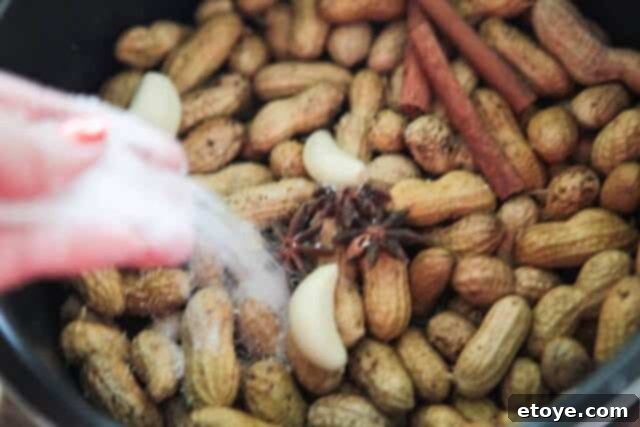
Step 3: Submerge the Peanuts Evenly
Raw peanuts naturally float to the surface of the water. To ensure every peanut cooks evenly and absorbs the flavorful brine, it’s essential to keep them submerged. A simple trick is to place a heavy, heat-safe plate directly on top of the peanuts in the pot. This acts as a weight, pushing them down into the liquid throughout the cooking process. If you don’t have a plate that fits, a smaller pot filled with water can also work as a makeshift weight.
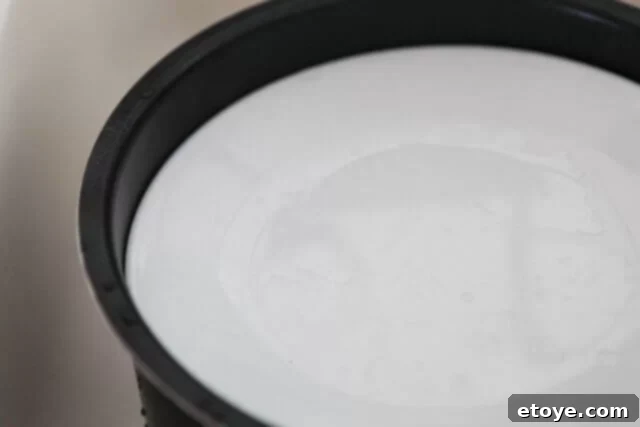
Step 4: Cook Until Tender
The cooking method largely depends on your preferred equipment and desired cooking time. Regardless of the method, the goal is to achieve tender, flavorful peanuts.
- Pressure Cooker Method (Fastest): This is the quickest way to achieve perfectly tender peanuts. Cook under high pressure for approximately 60 minutes. Remember that the pressure cooker will take some time to reach full pressure and then a cool-off period to naturally release steam. Always follow your manufacturer’s specific instructions for safety and best results.
- Slow Cooker Method (Hands-Off): For a more hands-off approach and deeper flavor infusion, a slow cooker is ideal. Cook on the “high” setting for 6-8 hours, or until the peanuts reach your desired tenderness. The longer, slower cook allows the flavors to truly meld.
- Stovetop Method (Traditional): Bring the pot to a rolling boil, then reduce the heat to low, cover the pot, and simmer gently for 3-4 hours. Periodically check the water level and add more if necessary to keep the peanuts submerged. Cook until they are soft and tender.
Pro Tip for Stovetop: If using dried raw peanuts (which require more cooking time), you can soak them overnight in cool water before proceeding with this recipe. This rehydrates them and can reduce stovetop simmering time to about 1 hour.
Chinese Street Food: A Culinary Staple
In China, boiled peanuts are much more than just a snack; they are an integral part of the vibrant street food culture. Alongside other beloved treats like fire-roasted chestnuts, you’ll find vendors selling warm bags of these aromatic peanuts, especially as the temperatures drop. This humble, affordable, and incredibly satisfying snack is a cold-weather staple, providing a quick source of warmth and energy.
The aroma of simmering spices and tender peanuts wafts through bustling markets and along busy streets, drawing passersby with its inviting scent. It’s a nostalgic treat for many, a simple pleasure that connects people to their culinary roots and the comforting embrace of traditional Chinese flavors. While I’m posting this recipe during the height of summer, it’s precisely these humble eats that evoke a longing for authentic Chinese cuisine and the cherished memories associated with them.
Peanuts with Flavor: The Magic of Spices
The true magic of Chinese Boiled Peanuts lies in the careful selection and balance of its aromatic spices. Star anise and cinnamon sticks are the stars of this show, transforming plain raw peanuts into a deeply flavorful experience.
Star anise lends a complex, slightly sweet, and unique licorice-like essence. While it carries a distinct flavor, please don’t let that “licorice” descriptor deter you – it is absolutely nothing like the polarizing taste of black licorice candy. Instead, it imparts a warm, aromatic depth that is both exotic and comforting. Cinnamon sticks complement this by adding a familiar sweetness and a rich, inviting fragrance that permeates every peanut.
Together with the sharp, savory notes of garlic, these spices create a brine that thoroughly infuses the peanuts, resulting in a snack that is bursting with layered flavors. For those who enjoy a bit of heat, consider adding a couple of dried red chilies to the pot. They provide a gentle warmth that balances the sweet and savory elements without overpowering them.
A classic and highly effective flavor combination includes three sticks of cinnamon, three star anise pods, three cloves of garlic, and three tablespoons of kosher or sea salt. If you’re fortunate enough to have exceptionally high-quality cinnamon sticks, you might find that one or two are sufficient to achieve the desired intensity. My preference for using three sticks often stems from a more budget-friendly choice of cassia bark, which requires a bit more to impart its full flavor.
Understanding Raw Peanuts: Green vs. Dried
Understanding the difference between raw peanut varieties is crucial for the success of your boiled peanut recipe. Raw peanuts commonly come in two primary forms:
- Raw Fresh Peanuts (AKA Green Peanuts): These are peanuts that have been recently harvested and come fresh out of the ground, still very moist within their shells. Green peanuts are the easiest and most preferred choice for making boiled peanuts because their high moisture content means they cook quickly and achieve a wonderfully tender texture without needing pre-soaking. They are packed with natural sweetness and are incredibly absorbent, making them ideal for soaking up the brining liquid.
- Raw Shelled and Air-Dried Peanuts: These peanuts have been harvested, shelled, and then air-dried to reduce their moisture content for longer storage. If you’re using this type of raw peanut, it is absolutely essential to soak them overnight in cool water before boiling. This rehydration process significantly reduces their cooking time and helps them achieve the desired soft, succulent texture. Without soaking, dried raw peanuts will take much longer to cook and may not become as tender.
Starting with raw fresh (green) peanuts simplifies the process immensely due to their inherent moisture. So, where can you find these seasonal gems? Raw fresh peanuts are typically available in the produce section of well-stocked Chinese and Western markets when they are in season. In the U.S., this usually spans from late summer through the fall. Look for plump, firm shells without any signs of mold or damage.
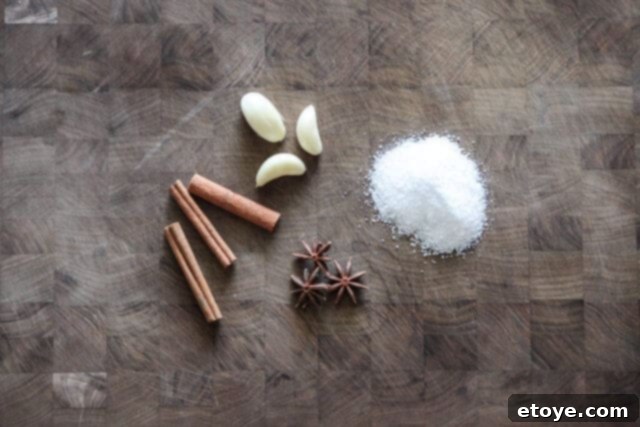
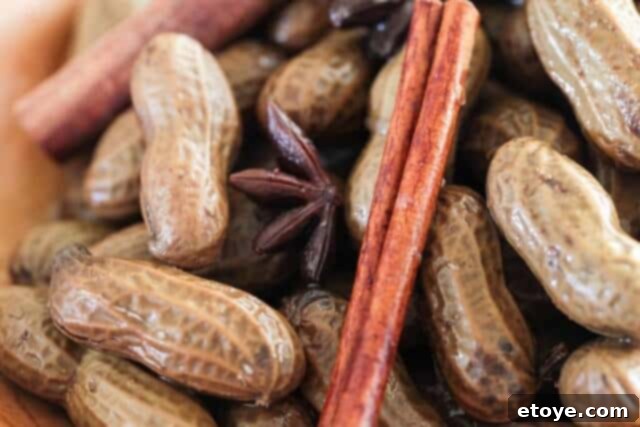
Top Tips for the Best Chinese Boiled Peanut Recipe
To ensure your Chinese Boiled Peanuts turn out perfectly tender and packed with flavor every time, keep these expert tips in mind:
- Ensure Adequate Water Coverage: Always use enough water to completely cover all the peanuts by at least 2-3 inches. As the peanuts absorb water and cook, the water level will drop, so starting with ample liquid prevents them from drying out or cooking unevenly. Using a plate or lid to weigh them down is crucial for full submersion.
- Adjust Spices to Your Liking: The beauty of this recipe is its flexibility. The provided spice ratios are a great starting point, but feel free to experiment. Add more star anise for a stronger licorice note, extra cinnamon for warmth, or a few dried red chilies for a spicy kick. Taste the brine during cooking and adjust the salt if needed.
- Choose Your Cooking Method Wisely: Whether you opt for a stovetop simmer, a pressure cooker, or a slow cooker, each method yields delicious results with varying time commitments. The stovetop is traditional, the pressure cooker is fastest, and the slow cooker offers a set-it-and-forget-it approach with deep flavor development.
- Keep Leftovers in Brining Liquid: This is perhaps the most crucial tip for storing boiled peanuts. Once cooked, store any leftover peanuts directly in their flavorful brining liquid. This prevents them from drying out, allows them to continue absorbing flavor, and maintains their tender texture. Refrigerate them in an airtight container for up to a week.
- Don’t Skimp on Soaking Dried Peanuts: If you’re using dried raw peanuts (shelled), an overnight soak (8-12 hours) in cold water is non-negotiable. This rehydrates them thoroughly, making them cook faster and ensuring they become soft and palatable. Without soaking, they’ll remain hard and unappetizing.
- Test for Doneness: The ideal texture for boiled peanuts is tender but not mushy, with a slight firmness. Periodically remove a peanut, crack it open, and taste it to gauge its tenderness, especially if you’re new to making them. Cooking times can vary based on the age and type of peanuts.
- Serve Warm or Chilled: Boiled peanuts are delicious served warm, directly from the pot, which enhances their aromatic qualities. However, many people enjoy them chilled, especially as a refreshing snack on a hot day. Experiment to find your preferred serving temperature.
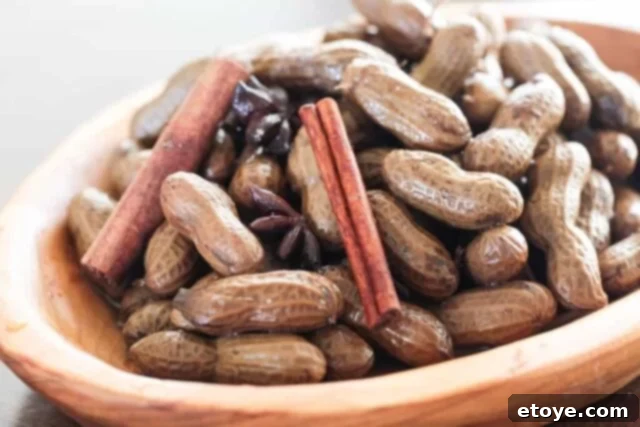
Explore More Delicious Peanut Recipes
If you’ve fallen in love with the versatile and delightful peanut, be sure to check out these other fantastic recipes that showcase its incredible flavor and texture:
- How to Make Crunchy Roasted Peanuts in the Microwave
- Chicken Satay with Peanut Noodles
- Peanut Pesto and Peas Pasta Salad
- Beef Satay Skewers with Habanero Peanut Sauce
Have you tried this irresistible Chinese Boiled Peanuts Recipe? We’d love to hear about your experience! Feel free to leave a star rating and share your thoughts in the comments below.
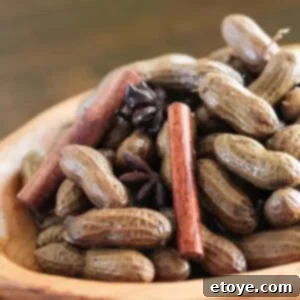
Classic Chinese Boiled Peanuts
Jaden Hair
Pin Recipe
Ingredients
- 1 pound raw peanuts (preferably green peanuts; if using dried raw peanuts, soak overnight)
- 3 cloves garlic (peeled and lightly smashed)
- 3 star anise pods
- 1-3 cinnamon sticks (adjust to preference and quality)
- 3 tablespoons kosher or sea salt
- Water (enough to cover peanuts by 3 inches)
Instructions
- Prepare the Peanuts: Thoroughly wash the raw peanuts under cold running water, removing any dirt, debris, or damaged peanuts. If using dried raw peanuts, soak them overnight in cool water to rehydrate.
- Combine Ingredients: Place the washed peanuts in a large pot. Add the peeled garlic cloves, star anise pods, cinnamon sticks, and kosher or sea salt. Fill the pot with water, ensuring it covers the peanuts by at least 3 inches when they are submerged.
- Submerge Peanuts (Optional but Recommended): To ensure even cooking and flavor absorption, place a heat-safe plate directly on top of the peanuts in the pot. This will keep them submerged in the brining liquid throughout the cooking process.
FOR PRESSURE COOKER:
- Cook under high pressure for 60 minutes. Allow the pressure to release naturally. Always follow your pressure cooker’s manufacturer instructions for safe operation.
FOR SLOW COOKER:
- Cook on the “high” setting for 6-8 hours, or until the peanuts are tender to your liking.
FOR STOVETOP:
- Bring the pot to a vigorous boil. Once boiling, reduce the heat to low, cover the pot, and simmer for 3-4 hours. Check periodically and add more hot water if needed to keep peanuts submerged. Cook until desired tenderness is reached.
- If peanuts were soaked overnight (for dried raw peanuts), stovetop simmering time can be reduced to approximately 1 hour or until tender.
- Serve and Store: Once cooked, taste a peanut to ensure it’s tender and flavorful. Serve warm or chilled. Store any leftover peanuts in their brining liquid in an airtight container in the refrigerator for up to a week to maintain moisture and flavor.
